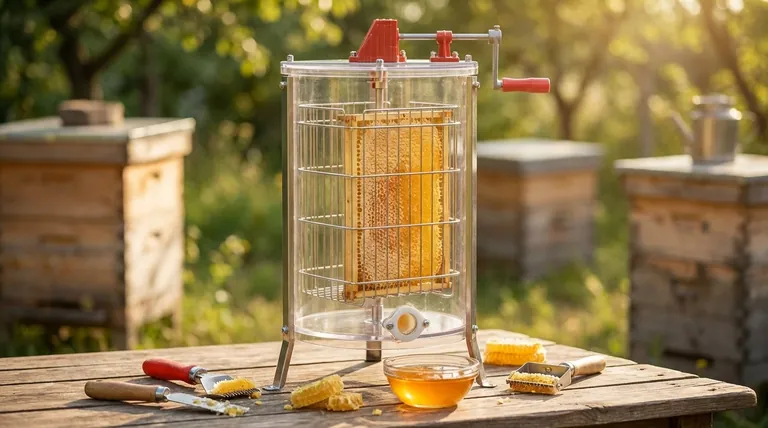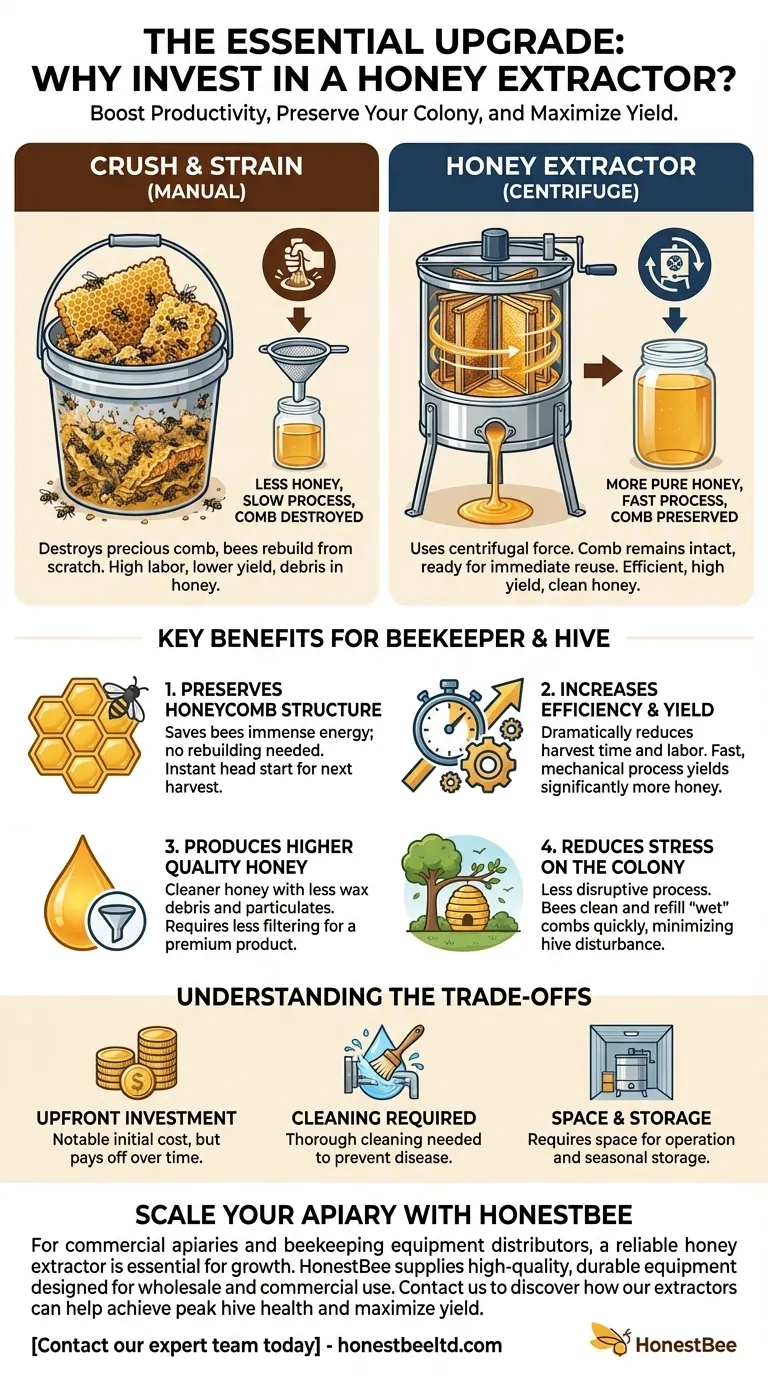Investing in a honey extractor is one of the most significant upgrades a beekeeper can make. This specialized centrifuge allows you to remove honey from the comb far more efficiently than manual methods. Critically, it does this without destroying the intricate wax honeycomb, which preserves a vital resource for your bees and leads to a healthier, more productive hive.
The true value of a honey extractor isn't just about getting honey out; it's about preserving the bees' most valuable asset—the honeycomb. By saving the comb, you save your bees immense time and energy, which directly translates to a more productive and sustainable apiary.

The Core Problem: The High Cost of Wax
To understand the importance of an extractor, you must first understand the value of honeycomb.
Why Honeycomb is a Precious Resource
Bees must consume large quantities of honey—estimates range from 6 to 8 pounds—just to produce a single pound of beeswax.
Building a complete comb is an enormous energy expenditure for the colony. This is energy that could otherwise be used for foraging, raising brood, and making more honey.
The "Crush and Strain" Alternative
The primary alternative to extraction is the "crush and strain" method. This involves scraping the entire comb into a bucket, mashing it, and straining the honey through a filter.
While simple, this method completely destroys the comb. The bees are forced to rebuild it from scratch, significantly slowing down future honey production.
How an Extractor Solves the Problem
A honey extractor uses centrifugal force to sling honey out of the wax cells. The beekeeper first uncaps the cells with a hot knife or fork.
The frames are then placed in the extractor's basket and spun. The force pushes the honey out against the drum wall, where it drips down to a collection point, leaving the delicate comb structure perfectly intact and ready for reuse.
Key Benefits for Beekeeper and Hive
Using an extractor creates a symbiotic benefit, improving outcomes for both the beekeeper and the bees.
Preserves the Honeycomb Structure
This is the single most important benefit. By returning empty, undamaged combs to the hive, you give your bees a massive head start. They can begin refilling the cells almost immediately.
Increases Efficiency and Honey Yield
For anyone with more than a couple of hives, an extractor dramatically reduces the time and labor needed to harvest honey. The mechanical process is fast, clean, and yields more honey than manual crushing and straining.
Produces Higher Quality Honey
Extracted honey is cleaner, containing far less wax debris and other particulates. This results in a higher-quality final product that requires less filtering before bottling.
Reduces Stress on the Colony
The entire process is less disruptive. Returning the "wet" combs (with residual honey) often encourages the bees to clean and refill them quickly, minimizing the disturbance to the hive's routine.
Understanding the Trade-offs
While highly beneficial, an extractor is a significant piece of equipment with its own considerations.
The Upfront Financial Investment
A quality extractor represents a notable financial cost. For a brand-new beekeeper with a single hive, this initial expense can be a significant barrier.
Cleaning and Maintenance
Extractors must be thoroughly cleaned after each use to prevent contamination and the spread of bee diseases. This process requires time, water, and effort.
Space and Storage
Honey extractors are bulky. You need adequate space not only to operate the machine during harvest but also to store it during the off-season.
Making the Right Choice for Your Apiary
Deciding when to invest in an extractor depends entirely on the scale and goals of your beekeeping operation.
- If you are a new beekeeper with one or two hives: You can begin with the crush and strain method to minimize initial costs, but plan to upgrade as your apiary grows.
- If you are a hobbyist with several established hives: An extractor is a highly recommended investment that will dramatically improve your efficiency and the long-term health of your colonies.
- If you are a commercial or sideline beekeeper: A honey extractor is not a luxury; it is an essential piece of equipment for a viable and profitable operation.
Ultimately, a honey extractor marks the transition from simply harvesting honey to sustainably managing your hives for peak health and productivity.
Summary Table:
| Benefit | Description |
|---|---|
| Preserves Honeycomb | Saves bees the immense energy of rebuilding wax, leading to a healthier, more productive hive. |
| Increases Efficiency | Dramatically reduces harvesting time and labor compared to manual crush and strain methods. |
| Improves Honey Quality | Produces cleaner honey with less wax debris, resulting in a higher-quality final product. |
| Reduces Colony Stress | A less disruptive process that allows bees to quickly refill combs, minimizing hive disturbance. |
Ready to enhance your apiary's productivity and sustainability?
For commercial apiaries and beekeeping equipment distributors, a reliable honey extractor is essential for scaling your operation. HONESTBEE supplies high-quality, durable beekeeping equipment designed for wholesale and commercial use.
Contact our expert team today to discuss your needs and discover how our extractors and supplies can help you achieve peak hive health and maximize your honey yield.
Visual Guide

Related Products
- HONESTBEE 3-Frame Manual Acrylic Honey Extractor
- Electric 8 Frame Honey Spinner Extractor Equipment for Beekeeping
- 8-Frame Electric Self-Reversing Honey Extractor Spinner for Commercial Honey Extraction Equipment
- Stainless Steel 3 Frame Manual Honey Extractor Spinner for Bee Honey Extraction
- electric honey extractor honey centrifuge 3 frame honey extractor stainless steel honey frame extractor
People Also Ask
- How often do beekeepers collect honey? Maximize Your Hive's Sustainable Yield
- What equipment is used for honey harvest? Essential Tools for Every Beekeeper
- What is the most common method for cleaning a honey extractor? Protect Your Honey & Equipment
- What is a fun and easy alternative to using a honey extractor for harvesting honey? Try the Crush and Strain Method
- How do you collect honey at home? A Beginner's Guide to Harvesting from Your Hive



















